|
|
|
Sort Order |
|
|
|
Items / Page
|
|
|
|
|
|
|
| Srl | Item |
| 1 |
ID:
137655
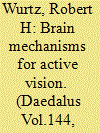

|
|
|
|
|
| Summary/Abstract |
Active vision refers to the exploration of the visual world with rapid eye movements, or saccades, guided by shifts of visual attention. Saccades perform the critical function of directing the high-resolution fovea of our eyes to any point in the visual field two to three times per second. However, the disadvantage of saccades is that each one disrupts vision, causing significant visual disturbance for which the brain must compensate. Exploring the interaction of vision and eye movements provides the opportunity to study the organization of one of the most complex, yet best-understood, brain systems. Outlining this exploration also illustrates some of the ways in which neuroscientists study neuronal systems in the brain and how they relate this brain activity to behavior. It shows the advantages and limitations of current approaches in systems neuroscience, as well as a glimpse of its potential future.
|
|
|
|
|
|
|
|
|
|
|
|
|
|
|
|
| 2 |
ID:
121851
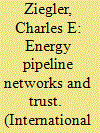

|
|
|
|
|
| Publication |
2013.
|
| Summary/Abstract |
Energy pipeline networks tie nations together in webs of interdependence that are mutually beneficial but which also make countries vulnerable. This article explores the relationship between political trust and energy pipelines connecting Russia and the European Union (EU). It seeks to explain low levels of trust in the EU-Russia energy relationship, varying levels of energy cooperation and trust within the EU toward Russia, and whether the EU-Russia energy relationship is representative of vulnerabilities shared by producers and consumers in other contexts. Rationalist approaches that focus on interests and reciprocity are incomplete and should be supplemented by a concept of trust based on normative factors. This article finds that political disputes with transit and consumer states, competing norms, and the legacy of mistrust from the Cold War (especially among certain East European countries) combined to form a uniquely toxic relationship.
|
|
|
|
|
|
|
|
|
|
|
|
|
|
|
|
| 3 |
ID:
175131
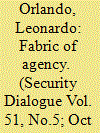

|
|
|
|
|
| Summary/Abstract |
Building on new trends in neuroscience and philosophy of mind, this article provides a roadmap for incorporating consciousness into social research. Drawing upon Alexander Wendt’s Quantum Mind and Social Science, it is argued that one of the greatest obstacles encountered by social research when approaching social reality is that it provides neither an epistemological nor an ontological place for consciousness. The present article intends to address that problem by introducing a sophisticated method of guided introspection that has the potential to revolutionize our understanding of agency. This method, whose epistemological situation is isomorphic to that of quantum physics, enables researchers to gain insight into the structures of decisionmaking processes. Such an endeavor is extremely relevant for security studies: the consideration of consciousness could lead to a radical new understanding of the dynamics of conflict, cooperation, strategic defense, political polarization, radicalization, violent extremism, and terrorism, as well as of the processes of social transformation required to cope with climate change. Moreover, bringing consciousness into social research could foster ongoing biological, evolutionary, and neuroscientific approaches to international relations. Thus, through the introduction of the ‘phenomenal consciousness’ of actors, it is shown how we can dive into the fountainhead of human agency and map mental processes.
|
|
|
|
|
|
|
|
|
|
|
|
|
|
|
|
| 4 |
ID:
137676
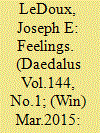

|
|
|
|
|
| Summary/Abstract |
Traditionally, we define “emotions” as feelings and “feelings” as conscious experiences. Conscious experiences are not readily studied in animals. However, animal research is essential to understanding the brain mechanisms underlying psychological function. So how can we make study mechanisms related to emotion in animals? I argue that our approach to this topic has been flawed and propose a way out of the dilemma: to separate processes that control so-called emotional behavior from the processes that give rise to conscious feelings (these are often assumed to be products of the same brain system). I will use research on fear to explain the way that I and many others have studied fear in the laboratory, and then turn to the deep roots of what is typically called fear behavior (but is more appropriately called defensive behavior). I will illustrate how the processes that control defensive behavior do not necessarily result in conscious feelings in people. I conclude that brain mechanisms that detect and respond to threats non-consciously contribute to, but are not the same as, mechanisms that give rise to conscious feelings of fear. This distinction has important implications for fear and anxiety disorders, since symptoms based on non-conscious and conscious processes may be vulnerable to different factors and subject to different forms of treatment.
|
|
|
|
|
|
|
|
|
|
|
|
|
|
|
|
| 5 |
ID:
130947
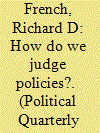

|
|
|
|
|
| Publication |
2014.
|
| Summary/Abstract |
Political science has paid scant attention to the way that citizens judge public policy, assuming that citizens do so, or should do so, in ways familiar to academics themselves, depending upon which of the various schools of thought they endorse. This paper argues that approaching citizens' judgement realistically requires attention to political psychology. Indeed, our conception of citizen judgement can be enriched by attention to research and theory in cognitive psychology and neuroscience. That work emphasises that much judgement occurs spontaneously and very rapidly, that it is involuntary and non-semantic and that it depends upon the emotional impact of experience rather than conscious weighing of situations against explicit standards of assessment such as science, self-interest or moral theory. A moral psychology for public life is sketched out, with implications for judgment by politicians.
|
|
|
|
|
|
|
|
|
|
|
|
|
|
|
|
| 6 |
ID:
196642


|
|
|
|
|
| Summary/Abstract |
The Russian word Imperskost’, which can be translated into English as ‘imperiality’, is a useful theoretical concept for scholarly writing in English that addresses individuals’ and countries’ imperial ambitions. In this note, I explore the meaning and relevance of this concept to our daily lives. Contrary to some existing definitions of Imperskost’ in terms of political economy, history, psychology (as an unconscious bias) and its primordial origins, I argue that this feeling is primarily personal and located in the human body. Imperskost’ is thus embodied as an emotion articulated and expressed as a sense of privilege, superiority and/or entitlement. Confronting Imperskost’ – whether one is a Russian citizen, a Russian speaker or not – is essential for overcoming it. Since scholarly works, including Central (Eur)Asian ethnography, can be sites for the formation and maintenance of Imperskost’, internal disciplinary criticism and reflection are necessary for its undoing. However, this process begins with the individual.
|
|
|
|
|
|
|
|
|
|
|
|
|
|
|
|
| 7 |
ID:
132374
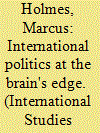

|
|
|
|
|
| Publication |
2014.
|
| Summary/Abstract |
Social neuroscience has seen a profound rise in other social science disciplines, such as economics, yet there has been relatively little systematic analysis of the usefulness of social neuroscience for international relations and the study of world politics. This article suggests that while there are many potential explanations for why this might be the case, one important barrier to adopting neuroscience may be our metaphysical assumptions and philosophical wagers. I suggest that if all politics is rooted in the brain, then two distinct arguments regarding agent-structure are plausible. One argument suggests that structure becomes redundant once the brain is accounted for; the other suggests that the brain simply drops out as epiphenomenal. After all, if all politics is reflected in the brain, then the brain itself is less interesting than the structure being reflected. These wagers ultimately relate to positions we take on the mind-body problem and well-known ideational-material divide. New research in neuroscience and philosophy of mind suggests that this binary distinction can be overcome, suggesting a new "via media" between ideas and material that may offer significant promise for both theory and practice.
|
|
|
|
|
|
|
|
|
|
|
|
|
|
|
|
| 8 |
ID:
161749
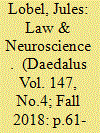

|
|
|
|
|
| Summary/Abstract |
This essay discusses the interface between neuroscience and the law. It underscores the potential for neuroscience to break down the division that currently exists in law between physiological and psychological harm and between physical and mental injury. To show how scientific knowledge can illuminate a complex legal issue, we analyze the recent use of neuroscience in evaluating the harm caused by prolonged solitary confinement.
|
|
|
|
|
|
|
|
|
|
|
|
|
|
|
|
| 9 |
ID:
197231


|
|
|
|
|
| Summary/Abstract |
The concept of cognitive warfare is currently gaining ground in the policy discussion and in academic research as a way of conceptualizing the ‘weaponization of the neurosciences’. Introducing the Science and Technology Studies-inspired concept of ‘neuropolitical imaginaries’ and assessing discussions on cognitive warfare launched by the NATO Innovation Hub in 2017, this article explores how the contemporary turn to the brain sciences in defense and security reimagines politics. The article argues that seeing the human mind as increasingly vulnerable to external interference redefines the nature of human agency by giving precedence to the skilful ‘cartographer’ employing neuroscientific techniques and methods for persuasion. This emerging vulnerability of the human mind reshapes security into a zero-sum game for ‘cognitive superiority’, making brain science scholars authorities in security. Finally, speaking to the literature on security expertise and science in security, the article argues that the envisaged arms race for cognitive superiority gives rise to a neurosecurity dilemma: as the neurosciences becomes entangled with security, neuroscientific practices simultaneously arise as a core vulnerability, making their work conditional upon compliance with security practices.
|
|
|
|
|
|
|
|
|
|
|
|
|
|
|
|
| 10 |
ID:
137654
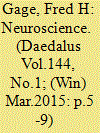

|
|
|
|
|
| Summary/Abstract |
Neuroscience is the scienti½c study of the nervous system (the brain, spinal cord, and peripheral nervous system) and its functions. The belief that the brain is the organ that controls behavior has ancient roots, dating to early civilizations that connected loss of function to damage to parts of the brain and spinal cord. But the modern era of neuroscience began–and continues to progress–with the development of tools, techniques, and methods used to measure in ever more detail and complexity the structure and function of the nervous system. The modern era of neuroscience can be traced to the 1890s, when the Spanish pathologist Santiago Ramón y Cajal used a method developed by the Italian physician Camillo Golgi to stain nerve tissues to visualize the morphology and structure of the neurons and their connections. The detailed description of the neurons and their connections by Cajal, his students, and their followers led to the “neuron doctrine,” which proposed that the neuron is the functional unit of the nervous system
|
|
|
|
|
|
|
|
|
|
|
|
|
|
|
|
| 11 |
ID:
152103


|
|
|
|
|
| Summary/Abstract |
Recent breakthroughs in neuroscience have led to increasing concern about its uses in warfare. This article challenges the primacy of dual-use frameworks for posing ethical questions concerning the role of neuroscience in national security. It brings together three fields – critical war studies, bio-ethics, and the history of medicine – to argue that such frameworks too starkly divide ‘good’ and ‘bad’ military uses of neurotechnology, thus focusing on the degradation of human capacities without sufficiently accounting for human enhancement and soldier rehabilitation. It illustrates this through the emergence of diagnoses of Traumatic Brain Injury and Polytrauma in the context of post-9/11 counterinsurgency wars. The article proposes an alternative approach, highlighting the historical co-production and homology of modern war and medicine so as to grapple with how war shapes neuroscience, but also how neuroscience shapes war. The article suggests new routes for thinking through the connections between war, society, science, and technology, proposing that we cease analysis that assumes any fundamental separation between military and civilian life.
|
|
|
|
|
|
|
|
|
|
|
|
|
|
|
|
| 12 |
ID:
137657
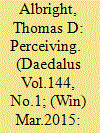

|
|
|
|
|
| Summary/Abstract |
Perceiving is the process by which evanescent sensations are linked to environmental cause and made enduring and coherent through the assignment of meaning, utility, and value. Fundamental to this process is the establishment of associations over space and time between sensory events and other sources of information. These associations provide the context needed to resolve the inherent ambiguity of sensations. Recent studies have explored the neuronal bases of contextual influences on perception. These studies have revealed systems in the brain through which context converts neuronal codes for sensory events into neuronal representations that underlie perceptual experience. This work sheds light on the cellular processes by which associations are learned and how memory retrieval impacts the processing of sensory information. Collectively, these findings suggest that perception is the consequence of a critical neuronal computation in which contextual information is used to transform incoming signals from a sensory-based to a scene-based representation.
|
|
|
|
|
|
|
|
|
|
|
|
|
|
|
|
| 13 |
ID:
125541
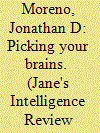

|
|
|
|
|
| Publication |
2013.
|
| Summary/Abstract |
Advances in neuroscience could have dramatic implication for the security and defense communities. Jonathan D Moreno examine the ways in which new technology that could improve human performance could be used by both militaries and militant alike.
|
|
|
|
|
|
|
|
|
|
|
|
|
|
|
|
| 14 |
ID:
137672
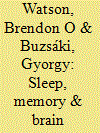

|
|
|
|
|
| Summary/Abstract |
Sleep occupies roughly one-third of our lives, yet the scientific community is still not entirely clear on its purpose or function. Existing data point most strongly to its role in memory and homeostasis: that sleep helps maintain basic brain functioning via a homeostatic mechanism that loosens connections between overworked synapses, and that sleep helps consolidate and re-form important memories. In this review, we will summarize these theories, but also focus on substantial new information regarding the relation of electrical brain rhythms to sleep. In particular, while REM sleep may contribute to the homeostatic weakening of overactive synapses, a prominent and transient oscillatory rhythm called “sharp-wave ripple” seems to allow for consolidation of behaviorally relevant memories across many structures of the brain. We propose that a theory of sleep involving the division of labor between two states of sleep–REM and non-REM, the latter of which has an abundance of ripple electrical activity–might allow for a fusion of the two main sleep theories. This theory then postulates that sleep performs a combination of consolidation and homeostasis that promotes optimal knowledge retention as well as optimal waking brain function.
|
|
|
|
|
|
|
|
|
|
|
|
|
|
|
|
|
|
|
|
|